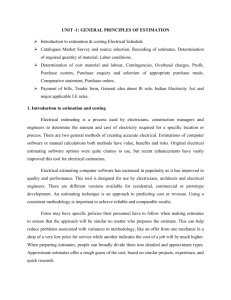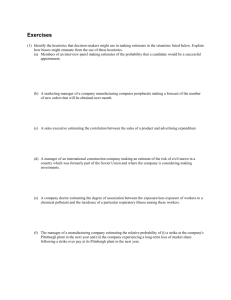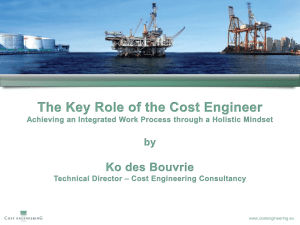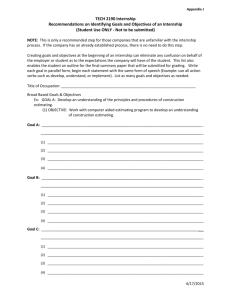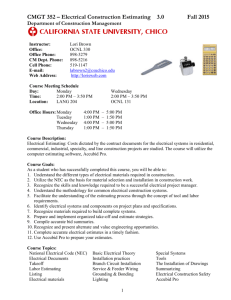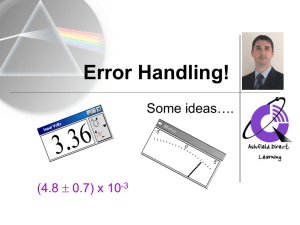PMI PMBOK and Estimating
advertisement
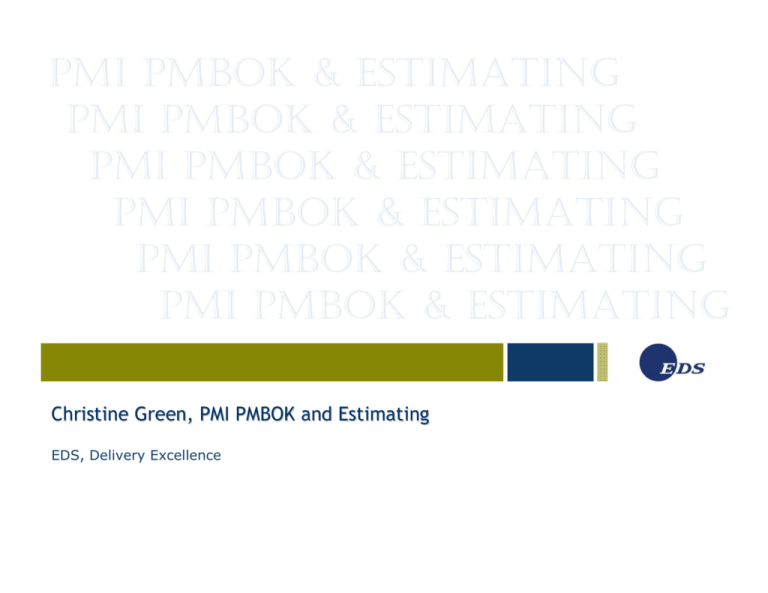
PMI PMBOK & ESTIMATING PMI PMBOK & ESTIMATING PMI PMBOK & ESTIMATING PMI PMBOK & ESTIMATING PMI PMBOK & ESTIMATING PMI PMBOK & ESTIMATING 03-23-05 Christine Green, PMI PMBOK and Estimating EDS, Delivery Excellence EDS - Who we are EDS has approximately 120,000 employees in 57 countries across the globe EDS is a leading global technology services company delivering business solutions to its clients. EDS founded the information technology outsourcing industry more than 40 years ago. Today EDS delivers a broad portfolio of information technology and business process outsourcing services to clients in the manufacturing financial services, healthcare, communications, energy, transportation and consumer and retail industries and to governments around the world. Presentation to ISMA Conference San Diego Agenda • Introduction • Project Scope and Time Management • Estimating Process • Applying Multiple Estimating Techniques • Next Steps and References • Questions Presentation to ISMA Conference San Diego PMI PMBOK and IFPUG Guideline to Software Measure (GSM) PMBOK, Third edition: GSM, Second edition: Key Process Areas: Key Chapters: • Estimating resources • Estimating • Estimating duration Estimating techniques: • Estimating cost. • Delphi Estimating techniques: • Bottom-up Estimating • Expert Judgement • Top-down Estimating • Analogous Estimating • Other Methods • Bottom-up Estimating • Tools • Parametric Estimating • Three-Point Estimate • Spreadsheets • PM Tools • Estimating Tools • Metrics History Presentation to ISMA Conference San Diego Estimating definitions in the PMBOK, GSM and CMMI Using the PMI PMBook definition • Estimating in the PMBook is not a unique process – but is mentioned in many knowledge area Processes • Estimating focus for Software development projects is usually on Effort – since effort is the biggest variable cost for most projects • Estimating in the GSM focuses separately on estimating • Estimating in the CMMI Book does not go into details of estimating techniques – but does mention the process of estimating for software projects ESTIMATING Presentation to ISMA Conference San Diego Agenda • Introduction • Project Scope and Time Management • Estimating Process • Applying Multiple Estimating Techniques • Next Steps and References • Questions Presentation to ISMA Conference San Diego Project Scope Management – Create WBS Scope Planning Scope Definition Create WBS Scope Verification Scope Control • Create WBS – Subdividing the major project deliverables and project work into smaller, more manageable components Presentation to ISMA Conference San Diego Project Scope Management – Create WBS Tools and Techniques • Work Breakdown Structure Templates • Decomposition Outputs Inputs • Project Scope Statement (updates) • Organizational Process Assets • Project Scope Statement • Project Scope Management Plan Create WBS • Approved Change Requests • WBS Dictionary • Scope Baseline • Project Scope Mgmt Plan (updates) e Presentation to ISMA Conference San Diego • Work Breakdown Structure • Requested Changes Project Time Management – Activity Definition Activity Definition Activity Sequencing Activity Resource Estimating Activity Duration Estimating Schedule Development Schedule Control • Activity Definition – Identifying and documenting the work that is planned to be performed to identify the deliverables at the lowest level in the Work Breakdown Structure (WBS), the work package Presentation to ISMA Conference San Diego page 9 • EDS Project Time Management – Activity Definition Tools and Techniques • Decomposition • Templates • Rolling wave planning • Expert judgment Inputs • Planning component • Enterprise environmental factors Outputs • Organizational process assets • Project scope statement • Work breakdown structure Activity Definition • Activity list • Activity attributes • Milestone list • Requested changes • WBS dictionary • Project management plan Presentation to ISMA Conference San Diego page 10 • EDS Project Time Management – Activity Resource Estimating Activity Definition Activity Sequencing Activity Resource Estimating Activity Duration Estimating Schedule Development Schedule Control • Activity Resource Estimating – Determining what resources and what quantities of each resource will be used, and when each resource will be available to perform project activities Presentation to ISMA Conference San Diego page 11 • EDS Project Time Management – Activity Resource Estimating Tools and Techniques • Expert judgment • Alternatives analysis • Published estimating data • Project management software Inputs • Bottom-up estimating • Enterprise environmental factors • Activity resource requirements • Organizational process assets • Activity list • Activity attributes • Resource availability • Project management plan Presentation to ISMA Conference San Diego Outputs Activity Resource Estimating • Activity attributes (updates) • Resource breakdown structure • Resource calendars (updates) • Requested changes page 12 • EDS Project Time Management – Activity Duration Estimating Activity Definition Activity Sequencing Activity Resource Estimating Activity Duration Estimating Schedule Development Schedule Control • Activity Duration Estimating – Estimate the amount of work effort, resources, and number of work periods needed to complete the schedule activity Presentation to ISMA Conference San Diego page 13 • EDS Project Time Management – Activity Duration Estimating Tools and Techniques • Expert judgment • Analogous estimating Inputs • Enterprise environmental factors • Parametric estimating • Three-point estimates • Reserve analysis • Organizational process assets Outputs • Project scope statement • Activity list • Activity attributes • Activity resource requirements Activity Duration Estimating • Activity duration estimates • Activity attributes (updates) • Resource calendars • Project management plan Presentation to ISMA Conference San Diego page 14 • EDS Project Time Management – Activity Duration Estimating Tools & Techniques • Expert judgment –Project scope statement, WBS, and project schedule definition provided by experienced and skilled team members • Analogous estimating – Using the actual duration of a previous, similar schedule activity as the basis for estimating the duration of a future activity • Parametric estimating – A quantitative estimate determined by multiplying the quantity of work to be performed by the productivity rate, i.e., x units at y per unit • Three-point estimates – Improving the estimate accuracy by considering most likely, optimistic, and pessimistic schedule activity durations • Reserve analysis – Incorporating additional time (contingency reserves) into the overall project schedule as recognition of schedule risk Presentation to ISMA Conference San Diego page 15 • EDS Agenda • Introduction • Project Scope and Time Management • Estimating Process • Applying Multiple Estimating Techniques • Next Steps and References • Questions Presentation to ISMA Conference San Diego Estimating and other related processes Scope management Estimating ….. Schedule development Cost Management Project Monitoring and Control The focus is to create an estimate that is reliable, traceable, accurate and complete, and where estimates for the project can be used even when the its scope is changing. If one wishes to focus on estimating as a unique process, it is necessary to take an approach which differs from that defined in PMBOK and CMMI definition. Estimates should be created so that they can continue to have validity as the Project Manager (PM), the Project team and the Clients defining the scope get wiser as the project runs Presentation to ISMA Conference San Diego Estimating Process Scope management The estimating process consist of some inputs, tools and techniques Estimating… A reconciliation of different estimates involving the estimator, the Project Manager and business and technical experts defines an agreed estimate Schedule development Cost Management Project Monitoring and Control Size Expert judgment WBS Bottom-Up Estimating Delivery Units Parametric Estimating Reconciliation Presentation to ISMA Conference San Diego Analogous Estimating Historical Information Three Point Estimating Size – input to estimating process The sizing process determines size in relation to project outputs FPA - Function Point Analysis provides a good size measure that depicts the software requirements by functionality as recognized by the users. SLOC - Source Lines of Code is also a frequently used size measure, but has the disadvantage of being heavily technology dependent. Both of these are recognised as industry benchmark size measures and should therefore be used in order to ensure sizing consistency across different projects Sizing consistency is also needed in order to utilise historical information and parametric estimating techniques Presentation to ISMA Conference San Diego FPA counting approach – and accuracy Function Point Analysis Components Robust Ratio ± 25-30% ± 30-35% Elementary Process Logical Files Transactional Functions EI: External Input EO: External Output EQ: External Inquiry Data Functions Limited ± 10-25% Detailed ± 10% DET (Data Element Type) Presentation to ISMA Conference San Diego ILF (Internal Logical File) EIF (External Interface File) Define their complexity with: FTR (File Type Referenced) DET (Data Element Type) RET (Record Element Type Sizing – Using Delivery Units and FPA Delivery units are useful as a way determining size which is project specific Use Cases Screen Delivery Units and size are usually closely related. Tables Could calibrate the link between the delivery units and the FPA Test Cases Design Document Presentation to ISMA Conference San Diego Function Point WBS - Task Based Estimating • Task based estimating using the WBS structure is the most common approach to estimating and is well documented. • There are a few key factors which should be considered from an estimating perspective: – A common phase based WBS structure – Relative effort by phase – The percentage distribution of project phases in terms of effort and duration • Main ROI – A list of tasks to be performed – Work related view of the project – A framework for tracking change against specific tasks – A common framework for creating a historical database (assuming the use of a common WBS structure in the organisation). Presentation to ISMA Conference San Diego Historical Information Historical information should consist of measurement information • Size •CR • Effort •Staff • Defects •Duration and in addition Project or Application Characteristics • influencers • characteristics information In CMMI this is called the Organisation’s Measurement Repository Main ROI • Reuse in future estimates and by other estimators in the same or different locations • Reuse of lessons learned regarding defects etc.. • Data to be used for Measurement and analysis • Tracking information by objective measured rather then subjective assessment • Enables the development of internal benchmarks “The disadvantage of men not knowing the “ past is that they do not know the present” (G. K. Chesterton) Presentation to ISMA Conference San Diego Agenda • Introduction • Project Scope and Time Management • Estimating Process • Applying Multiple Estimating Techniques • Next Steps and References • Questions Presentation to ISMA Conference San Diego Using Multiple Estimating Techniques • Use different Techniques • Use different resources to perform the techniques • Ensure the right people give input • Ensure that apples are compared with apples • Remember to document any assumptions, constraints or risks that are identified during estimating Main ROI • Using more than one technique - Validation of estimates • More objective approach than usual bottom-up approach • Peer review of estimates • Ensure ability to track and monitor progress, productivity and Quality using historical information like expected defect etc. Presentation to ISMA Conference San Diego Bottom-up estimate Create WBS 5.3 Activity Definition 6.1 Activity resource Estimating 6.3 The Numbers refer to PMBOK Third edition Presentation to ISMA Conference San Diego Activity Duration Estimating 6.4 Schedule development 6.4 Bottom-up estimating • Make sure to include team approve/agreement of the lower level estimates • Should be linkable to the WBS • Look out for missing overhead – such as PM work, Review or Rework effort • Create a bottom-up estimate so that it can be matched to other estimating technique outputs. Main ROI • Expert view of task’s and deliverables • Expert view on estimates • Expert ability to identify issues (remember to record these) early in the life cycle • Team agreement on tasks to be performed • Decompose / roll-up activities to a level that makes reliable estimates “The accuracy of bottom-up estimating is driven by the size and complexity of the work identified at the lower levels. Generally smaller work scopes increase the accuracy of the estimates. “ PMBook, Third edition Presentation to ISMA Conference San Diego Three Point Estimating Phase Most likely Low Expected time High Variance Refine Scope and Analyze Requirements 10 15 35 16 17 Design (High and low level design) 15 20 66 24 72 Produce (Coding, Code Review) 44 55 66 48 13 Unit & Integration Testing 60 88 130 80 136 Release (QC & Staging) 80 60 40 47 44 Acceptance Testing 10 15 20 13 3 8 16 32 16 16 20 30 40 27 11 247 299 429 271 920 Implement Project Management (Start-up, Plan, Manage, Closedown) Total • Three point estimating is a statistical technique which can be used effectively together with bottom up estimating. • The biggest benefit from using this estimating approach is the ability to compare the Expert Estimate with the variance. It is always recommended that you should investigate major variance. Presentation to ISMA Conference San Diego Analogues Estimating Project Characteristic Project History DB Similar Project Measures Staff Duration Effort Defect The analogous estimating technique uses information from similar projects to establish a cost estimate based on the data available. Often used as simple comparison of previous similar projects or past enhancements projects on the same application Main ROI • Usage of knowledge learned from previous project • Learn from historical data & cross check with it Be aware that when identifying analogues estimates – the project might benefit from the reuse of other areas from the project – ex. Work product, process definition etc. Presentation to ISMA Conference San Diego Parametric Estimating Statistical analysis Project History DB Project Characteristic Estimating Math Model & benchmark data Estimating result • Parametric estimating uses a mathematical model using various sources of data to create a series of views of possible delivery scenarios • Use Parametric estimates to produce several scenarios. • Create scenarios to show the impact of the constraints and influences affecting Productivity or Quality. Presentation to ISMA Conference San Diego Using a tool for parametric estimating Project Characteristics Staff Duration FPA Slim Effort Defects EDS & Industry Data e Tools usually makes excellent reports, and these make it easy to show the difference in scenarios e.g. the impact of constraints – such as duration Presentation to ISMA Conference San Diego Main ROI from process perspective using Parametric Estimating • Establish a range of possible and impossible region for estimates • Allows comparison with internal and external data from successful projects • Enables reports for – PMs and Programme Managers – Senior Management and – clients to demonstrate optimal delivery timescales and cost drivers and to demonstrate associated Risk with time or staff constraints Presentation to ISMA Conference San Diego Agenda • Introduction • Project Scope and Time Management • Estimating Process • Applying Multiple Estimating Techniques • Next Steps and References • Questions Presentation to ISMA Conference San Diego Next Step – After the Estimate • Develop schedule – Including impact of combining the staffing and duration constrains – Remember impact on effort of utilizing different staffing experience • Cost Estimate – Staffing rate – Other cost associated with purchase – Travel, training etc… Always Take CAR(e) Constraints, Assumptions, Risks Presentation to ISMA Conference San Diego References • PMI, A Guide to the Project Management Body of Knowledge (PMBOK® Guide), Third Edition by Project Management Institute, Project Management Institute © 2004 (388 pages), ISBN:193069945X • SEI, CMMI for Systems Engineering, Software Engineering, Integrated Product and Process Development, and Supplier Sourcing (CMMI-SE/SW/IPPD/SS, V1.1) Staged Representation CMU/SEI-2002-TR-012 ESC-TR-2002-012 • David Garmus, David Herron, Function Point Analysis; Measurement Practices for Successful Software Projects, Addison-Wesley, 2001 • David Garmus, David Herron, Measuring The Software Process: A Practical Guide To Functional Measurements, Prentice Hall, 1996 • IFPUG et. Al, IT Measurement; Practical Advice from the Experts, Addison-Wesley, April 2002 • Evolving Standards in Function Point/Lines of Code Ratios, Koni Thompson Houston; Presented to 18th International Forum on COCOMO and Software Cost Modeling; 2003 • Guidelines to Software Measurement, Release 2, IFPUG, www.ifpug.org • IFPUG Function Point Counting Practice Manual, v. 4.2.1, IFPUG, www.ifpug.org • Christine Green, CMMI & FPA - – the link and benefit of using FPA when rolling out CMMI, ESEPG & IFPUG conference 2004 Presentation to ISMA Conference San Diego Questions? 03-23-05 Contact Information Christine Green, EDS Telephone: +45 51 59 70 23 Email: christine.green@eds.com



